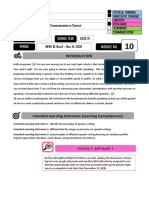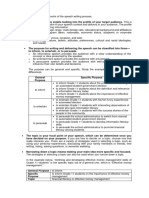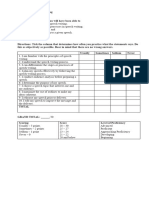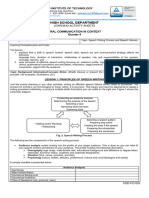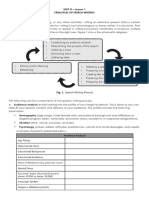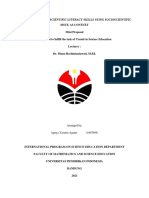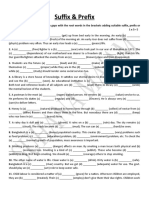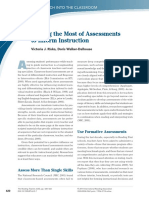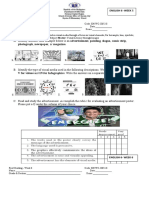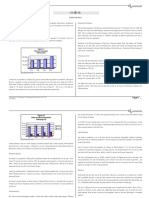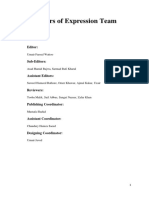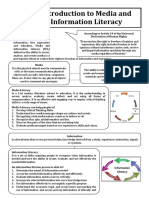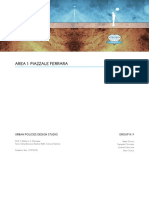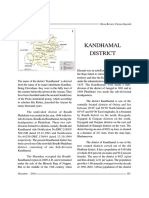Principles of Effective Speech Writing Grade9a
Uploaded by
BC JoshPrinciples of Effective Speech Writing Grade9a
Uploaded by
BC JoshGood Morning Grade 9
Activity
Study the following scenario:
You were assigned by your principal to be your school’s
events planner. Now your task is to organize a welcome
program for a foreign visitor.
How did you plan for the program?
What difficulties did you encounters while planning?
Usually Sometime Seldom Never
SELF-AUDIT s
1. I am familiar with the principles of speech writing.
2. I understand the speech writing process.
3. I can differentiate the stages or processess of speech
writing.
4. I plan my speech effectively by following the speech
writing process.
5. I conduct audience analysis before preparing a speech.
6. I determine the purpose of my speech.
7. I choose a speech topic that interests me and my
audience.
8. I rehearse my speech prior to delivery.
9. I maximize the use of outlines to make my ideas
Principles of Effective
Speech Writing
The Speech Writing Process
Schematic Diagram
• Conducting an audience analysis
• Determining the purpose of the speech
• Selecting a topic
• Narrowing down a topic
• Gathering Data
• Editing and /or Revising
• Rehearsing • Selecting a speech pattern
• Preparing an outline
• Creating the body of the speech
• Preparing the introduction
• Preparing the conclusion
Components of the speech writing process
1. Establish a purpose
Informative speech-
provides the audience with
a clear understanding of
the concept or idea
presented by the speaker
1. Establish a purpose
Entertainment speech-
provides the audience
with amusement.
1. Establish a purpose
Persuasive speech
provides the audience
with well-argued ideas
that can influence their
own beliefs and
decisions.
General Purpose Specific Purpose
To inform • To inform Grade 9 students about the
process of conducting an automated
student government election.
• To inform Grade 9 students about the
definition and relevance of information
literacy today.
• To inform Grade 9 students about the
importance of effective money
management.
General Purpose Specific Purpose
To entertain • To entertain Grade 9 students with
his /her funny experience in automated
election.
• To entertain Grade 9 students with
interesting observations of people who
lack information literacy.
• To entertain Grade 9 students with the
success stories of the people in the
community.
General Purpose Specific Purpose
To persuade • To persuade the school administrators
to switch from manual to automated
student government election.
• To persuade Grade 9 students to
develop information literacy skills
• To persuade the school administrators
to promote financial literacy among
students.
2. Identify your audience
Audience analysis- entails looking into the profile of your target
audience. This is done so you can tailor-fit your speech content
and delivery to your audience.
The profile includes the following information.
Q. Demography (age range, male-female ratio, educational
background and affiliations or degree program taken,
nationality, economic status, academic or corporate
designation.
Q. Situation (time, venue, occasion, and size)
Q. Psychology (values, beliefs, attitudes, preferences,
cultural and racial ideologies, and needs)
A sample checklist is presented below.
Audience Analysis
Age Range
Male-Female Ratio
Educational Background
Educational Institution
Place of Residence (city, province, town
Marital Status
Economic Status ( Household income above 30,000 or below 30,000
Language Spoken
Religious Affiliation/ beliefs
3. Organize your speech
Organize the speech using an outline.
1. Outline- is a hierarchical list that shows the
relationship of your ideas. Experts in public
speaking state that once your outline is ready,
two-thirds of your speech writing is finished. A
good outline helps you see that all the ideas are
in line with your main idea or message. The
elements of an outline include introduction, body,
and conclusion.
A. Introduction- is the foundation of your
speech. Here, your primary goal is to get the
attention of audience and present the subject or
main idea of your speech. The following are
some strategies:
Use a real-life experiences
Start with a familiar or strong quote
Use facts or statistics
Tell a personal story
B. Body of the speech- provides
explanations, examples,or any details that
can help you deliver your purpose and
explain the main idea of your speech.
• Present real-life or practical examples.
• Show statistics
• Present comparison
• Share ideas from the experts or
practitioners.
C. Conclusion- restate the main idea of your speech.
Furthermore, it provides a summary,emphasizes the
message, and calls for action. While the primary goal of the
introduction is to get the attention of your audience, the
conclusion aims to leave the audience with a memorable
statement.
• Begin your conclusion with a restatement of your
message.
• Use positive examples, encouraging words, or memorable
lines from songs or stories familiar to your audience
• Ask a question or series of questions that can make your
audience reflect or ponder.
Topic is your focal point of your speech, which
can be determined once you have decided on
your purpose. If you are free to decide on a
topic, choose one that really interests you.
There are a variety of strategies used in
selecting a topic, such as using your personal
experiences, discussing with your family
members or friends, free writing, listing, asking
questions, or semantic webbing.
Narrowing down a topic
means making your main
idea more specific and
focused. The strategies in
selecting a topic can also be
used when you narrow
down a topic.
General Purpose To inform
Specific Purpose To inform Grade 9 students on the importance of
effective money management
Topic Financial Literacy or Effective money management
Narrowing down a Effective money management.
topic through listing Effective money management of Grade 9
students.
Developing an effective money management of
Grade 9 students
Defining and developing effective money
management skills of Grade 9 students.
Data Gathering- is the stage where you
collect ideas information,sources, and
references relevant or related to your
specific topic. This can be done by visiting
the library, browsing the web, observing a
certain phenomenom or event related to
your topic, or conducting an interview or
survey. The data that you will gather will
be very useful in making your speech
informative, entertaining, or persuasive.
Writing patterns, in general, are structures that
will help you organize the ideas related
to your topic.
Examples: biographical, categorical/topical,
causal,chronological,comparison/contrast,
problem-solution, and spatial.
Different patterns from which you can
select the one that best suits your topic
and/or purpose.
Pattern Description Examples
Biographical Presents Specific To inform my audience
description of your Purpose about my grandfather, the
life or of a person, late former President
famous or not Ramon Magsaysay.
Specific Describing the life and
Topic works of my grandfather,
the late former President
Ramon Magsaysay
Pattern Description Examples
Categorical/ Presents Specific To persuade the community
Topical related Purpose members to reduce, reuse, and
categories recycle as means of eliminating
supporting the garbage and protecting the
topic environment.
Specific Why the community members
Topic to reduce, reuse, and recycle
as means of eliminating
garbage and protecting the
environment.
Pattern Description Examples
Causal Presents Specific To inform my
cause-effect Purpose audience on the
relationships effects of overeating
Specific Explaining the
Topic possible effects of
overeating to one’s
health.
Pattern Description Examples
Chronological Presents the Specific To inform my audience
idea in time Purpose about the significant
order events in the 1986 EDSA
Revolution or People
Power.
Specific Describing the significant
Topic events before,during, and
after the 1986 EDSA
Revolution or People
Power.
Pattern Description Examples
Comparison Presents Specific To persuade the
/ Contrast comparison/ Purpose audience that living in
contrast of two the Philippines is better
or three points than living in Australia.
Specific Explaining why the
Topic Philippines is more
habitable than Australia
Pattern Description Examples
Problem- Presents an identified Specific To persuade the audience to
solution problem, its causes, Purpose support the educational
and recommended programs of the national
solutions government.
Specific Explaining the reasons for
Topic supporting the government’s
educational programs seen
as the primary means of
increasing the literacy rate in
the Philippines.
Editing/Revising your written speech involves correcting
errors in mechanics, such as grammar, punctuation,
capitalization, unity, coherence, and others. Andrew
Dlugan (2013), an award-winning public speaker, lists
six power principles for speech editing.
1. Edit for focus
“So, what’s the point? What’s the
message of the speech?”
2. Edit for clarity
“I don’t understand the message
because the examples or
supporting details were confusing.”
3. Edit for conclusion
“The speech was all over the
place; the speaker kept talking
endlessly as if no one was listening to
him/her.”
4. Edit for continuity
“The speech was too difficult to
follow; I was lost in the middle.”
5. Edit for variety
I didn’t enjoy the speech
because it was boring.”
6. Edit for impact and beauty
“There’s nothing really special
about the speech.”
Rehearsing gives you an opportunity to
identify what woks and what does not
work for you and for your target
audience.
Some strategies include reading your
speech aloud, recording for your own
analysis or for your peers or coaches to
give feedback on your delivery. The best
thing to remember at this is: “Constant
Some Guidelines in Speech Writing
• Keep your words short and simple. Your speech
is meant to be heard by your audience, not read.
• Avoid jargons, acronyms, or technical words because
they confuse your audience.
• Make your speech more personal. Use the personal
pronoun “I,” but take care not overuse it. When you need to
emphasize collectiveness with your audience, use the
personal pronoun “we.”
• Use active verbs and contractions because they add to
the personal and conversational tone of your speech.
Some Guidelines in Speech Writing
• Be sensitive of your audience. Be very
careful with your language, jokes, and
nonverbal cues.
• Use metaphors and other figure of speech
to effectively convey your point.
• Manage your time well; make sure that the
speech falls under the time limit.
Performance Task: Individual Activity
Following the speech writing
process, prepare / plan a speech to
be delivered in class. As you go
along, make sure to fill in the details
in the columns with the ideas you
have decide on.
Performance Task: Individual Activity
A.. Conduct a general analysis. Use the sheet below.
General Audience Analysis
Age Range
Male-Female Ratio
Educational Background
Educational Institution
Place of Residence (city, province, town)
Marital Status
Economics Status (Household income above 30,000 or below
30,000)
Language spoken
Religious Affiliations / beliefs
Performance Task: Individual Activity
B. Identify your general and specific purpose.
General
Purpose
Specific
Purpose
Performance Task: Individual Activity
C. Identify your topic. Use any strategy learned from
this lesson.
General Purpose
Specific Purpose
Topic
Performance Task: Individual Activity
D. Narrow down your topic. Use any strategy learned
from this lesson.
General Purpose
Specific Purpose
Topic
Specific (Narrowed-down)
Topic
Performance Task: Individual Activity
E. Prepare and choose you writing patterns. You
can use biographical, categorical/ topical, causal,
chronological, comparison / contrast, problem-solution.
General Purpose
Specific Purpose
Topic
Specific (Narrowed-
down) Topic
Writing patterns
You might also like
- Principles in Speech Writing and DeliveryNo ratings yetPrinciples in Speech Writing and Delivery56 pages
- Principles of Speech Writing Report (Oral Com)No ratings yetPrinciples of Speech Writing Report (Oral Com)5 pages
- Quarter II - Speech Wriitng Lectures Jvr2022No ratings yetQuarter II - Speech Wriitng Lectures Jvr20224 pages
- (RAW) Lesson 6 - Principles of Speech WritingNo ratings yet(RAW) Lesson 6 - Principles of Speech Writing4 pages
- Principles of Speech Writing Principles of Speech Writing100% (3)Principles of Speech Writing Principles of Speech Writing4 pages
- Principles of Speech Writing Oral CommunicationNo ratings yetPrinciples of Speech Writing Oral Communication30 pages
- Principles-in-Speech-Writing-and-DeliveryNo ratings yetPrinciples-in-Speech-Writing-and-Delivery54 pages
- Q2 Oral Communication in Context Module 3 Principles of Effective Speech WritingNo ratings yetQ2 Oral Communication in Context Module 3 Principles of Effective Speech Writing21 pages
- Oral Communication: Module 6: Using Principles of Effective Speech WritingNo ratings yetOral Communication: Module 6: Using Principles of Effective Speech Writing40 pages
- UNIT III - Lesson 1 - Principles of Speech WritingNo ratings yetUNIT III - Lesson 1 - Principles of Speech Writing6 pages
- Q2 - Module 1 - Principles of Effective Speech Writing71% (7)Q2 - Module 1 - Principles of Effective Speech Writing7 pages
- SPEECH-WRITING - PPTX 20241029 091207 0000No ratings yetSPEECH-WRITING - PPTX 20241029 091207 000020 pages
- From Classroom to Podium: A Student's Guide to Powerful Public Speaking & Presentation SkillsFrom EverandFrom Classroom to Podium: A Student's Guide to Powerful Public Speaking & Presentation SkillsNo ratings yet
- Final Assignment (TSL015) : Name: Muhammad Haikal Bin Amran Group: T12 STUDENT ID: 2019221002No ratings yetFinal Assignment (TSL015) : Name: Muhammad Haikal Bin Amran Group: T12 STUDENT ID: 201922100212 pages
- Stem 11 Core Applied Specialized GAS 11 CoreNo ratings yetStem 11 Core Applied Specialized GAS 11 Core2 pages
- GS 2022 - 2023 Student Handbook (Working Document)No ratings yetGS 2022 - 2023 Student Handbook (Working Document)78 pages
- Child Marriage and Kanyashree Prakalpa Exploring Perception and Attitude Changes Among Adolescence GirlsNo ratings yetChild Marriage and Kanyashree Prakalpa Exploring Perception and Attitude Changes Among Adolescence Girls7 pages
- Arranged By: Agnya Yasmin Agami (1807693)No ratings yetArranged By: Agnya Yasmin Agami (1807693)9 pages
- Building and Enhancing New Literacies Across The CurriculumNo ratings yetBuilding and Enhancing New Literacies Across The Curriculum5 pages
- Head Start in Reading: Teach Your Child To Read0% (1)Head Start in Reading: Teach Your Child To Read35 pages
- BENLAC Group 2 Globalization and Cultural and Multicultural Literacy QuizNo ratings yetBENLAC Group 2 Globalization and Cultural and Multicultural Literacy Quiz5 pages
- Research Capabilities of Senior High School Students: January 2018No ratings yetResearch Capabilities of Senior High School Students: January 20189 pages
- Topic/Lesson Name Content Standards Performance Standards Learning CompetenciesNo ratings yetTopic/Lesson Name Content Standards Performance Standards Learning Competencies8 pages
- Virtual Inequality Beyond The Digital DivideNo ratings yetVirtual Inequality Beyond The Digital Divide212 pages
- Lec-15 (Loacal Issues in Community Welfare)No ratings yetLec-15 (Loacal Issues in Community Welfare)21 pages
- Kandhamal District: Orissa Review (Census Special)No ratings yetKandhamal District: Orissa Review (Census Special)4 pages
- Download (Ebook) Book Smart: How to Develop and Support Successful, Motivated Readers by Anne E. Cunningham, Jamie Zibulsky ISBN 9780199843930, 0199843937 ebook All Chapters PDF100% (19)Download (Ebook) Book Smart: How to Develop and Support Successful, Motivated Readers by Anne E. Cunningham, Jamie Zibulsky ISBN 9780199843930, 0199843937 ebook All Chapters PDF55 pages















